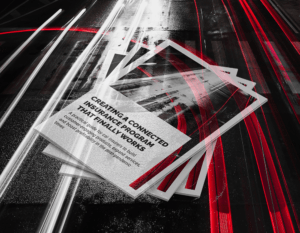
Further, Faster, Cheaper: How Data Analytics Helps Mobility Businesses Go an Extra Mile
A practical guide for mobility businesses on how to make the most out of their data and build data-centric solutions. … Read More
As worldwide data is growing exponentially, car insurance companies are tapping into IoT-based technologies to gain an edge. By leveraging data, they may unlock significant benefits, from improving the cost/claim ratio to providing distinctive and personalized services. What do they need to embrace the evolving trend of connected insurance? We explain.
Connected insurance (or IoT insurance) uses the data from connected devices, such as telematics equipment installed in the vehicle or trip recorder mobile apps, to determine risks more precisely. This data is further aggregated and analyzed to offer accurate insights into each person’s driving behavior, enable more accurate customer segmentation, and develop innovative insurance products, such as usage-based rewards programs.
Because of the tremendous potential of telematics in reducing costs, the insurance market has lately emerged as one of the fastest-growing sectors in the global IoT area. It is expected to reach nearly $403 billion within the next five years, rising at a stunning CAGR of 54% over the forecast period.
These results indicate that connected insurance is gaining momentum, and several factors contribute to that trend. One of them is the continuous advancement in telematics, which no longer relies on basic static data generated by external devices. Instead, it factors in dozens of complex vehicle systems and contextual parameters to paint a complete picture of the driver’s behavior in particular circumstances, all this directly coming from the vehicle’s embedded IoT.
Another enabler contributing to the increasing interest in IoT car insurance is the rising adoption of predictive analytics. This technology has permeated the mainstream in recent years. It is pulling on increasingly more complex machine learning and AI processes and algorithms to produce insights insurers can act on. In addition, the growth of 5G and enhancements of other connectivity protocols have further lifted the potential for connected technologies.
Finally, somewhat unexpectedly, insurance data analytics owes the accelerated development to the pandemic. On the one hand, digital transformation in business has picked up speed amid lockdowns and social distancing measures, which opened a new chapter for innovation. As companies went online, the use and popularity of digital insurance channels surpassed that of direct broker services, which have usually been limiting the deployment of telematics-based insurance. On the other, many industries increased their investment in insurance when faced with unprecedented times. Individual consumers, too, became much more open to new insurance offerings leveraging disruptive technologies, and specifically IoT-based insurance.
IoT can drive fundamental change in the car insurance industry, bringing insurers closer to customers on an individual level and empowering better decision-making through insights. In particular, the following key opportunities are arising for car insurance providers from the use of advanced car telematics:
The growing usage of IoT opens a new opportunity for insurance providers to innovate their offerings and reduce the premium and risk-related costs. Creating accurate risk profiles based on driver behavior, usage of driver assistance systems and the context of driving, is a gateway to competitive products that delight customers and compel them to stay.
For example, insurers can use actionable, telematics-based insights from analytics to provide individual driver discounts matching their profile or build a unique rewards program. In addition, by enabling smart pricing, data-based solutions further help insurers maximize profit margins and design profitable pricing strategies that unlock bigger sales. Telematics also opens the door for usage-based, or pay-as-you-drive insurance, where the cost of insurance changes dynamically depending on the usage, vehicle, and driving behavior.
Lowering claims payment is essential for high underwriting income. Unfortunately, a quick look at research data confirms that rising claims frequencies and persisting severity increases continue to eat into insurers’ profits. In the first half of 2021, 70% of the largest US private auto insurers saw their loss ratio deteriorate by double-digit percentage points. Telematics usage-based insurance solutions can be instrumental in reversing this negative trend by accelerating the claims process and thus reducing claims costs.
Adopting a telematics-powered solution can give insurers instant notification of a claim’s incident, shortening the time between the first notification of loss and the claim resolution. But facilitating incident assessment isn’t the only gain that helps reduce the loss ratio. Cutting-edge predictive analytics solutions also help predict and prevent many incidents, leading to lower auto claims’ number and severity.
Data analytics uncovers valuable insights into customer behavior that insurers can use to better align their offering with consumer wants and needs. And diversify away from traditional premium discounts, offering a range of value-added products and services instead. For example, non-insurance rewards serving as an extension of core insurance products are an extremely effective way to maintain customer loyalty. By tapping into the power of data with predictive analytics solutions, insurance companies can discover what kind of reward specific customers will appreciate most, whether it’s roadside assistance, fast claim management, or restaurant coupons, and meet these expectations.
Besides, policyholders also benefit from digital insurance powered by data collection by minimizing the latency between an incident and the claim’s settlement. The insurer’s speedy and efficient resolution of cases translates to their satisfaction, which, in turn, positively impacts retention and loyalty. Additionally, by tapping into the power of data, insurers gain the knowledge essential to enhance their products and services in line with the dynamically shifting expectations of modern consumers.
Finally, connected insurance marks the era of true insurance personalization, where powerful data analytics underpins solutions to tailor each offering to a particular person instead of a broad customer segment. By exploiting data collected from mobile apps and in-car devices, insurers can evolve their products according to individual customers’ expectations and build more focused marketing campaigns to reach more leads, convert them more efficiently, and keep longer as happy customers.
Key Takeaway: The pandemic-induced uptake in digital transformation initiatives across industries has contributed to the volumes of data pouring in from every corner. And the auto insurance sector is no different. Gone are the days when insurance could only rely on traditional, static explanatory variables, like driver’s age, experience, and previous claim history, for building their product offering and engaging with customers.
The IoT data transformation is in motion, and now, the ball is in insurers’ court to embrace it. The growing market for telematics and AI-based trends are the main drivers for adopting connected car insurance that combines driver behavior with the dynamically-changing context of driving to tailor usage-based insurance programs for new and existing customers. As a result, IoT-based insurance provides a meaningful opportunity for insurers to fulfill their customers’ needs through a digital channel while improving their financial outcomes and gaining a competitive edge.

A practical guide for mobility businesses on how to make the most out of their data and build data-centric solutions. … Read More

Motion-S, the Luxembourg-based data-driven mobility analytics company, announced today that the board decided to strengthen the company’s focus on mobility data analytics solutions. New solutions based on OEM-connected car data will be a centerpiece of the company’s offer. Motion-S will continue to expand its business activities related to its white-labeled insurance telematics platform and fleet optimization API that covers safe and sustainable driving and predictive vehicle wear analytics.
To drive the company to the next level, the board of directors further decided on a change in the company’s management. As of March 01st, 2023, Andres Petrillo will take over the position of CEO from German Castignani, co-founder of the company. The board thanks German for his outstanding engagement in leading the company successfully during the past three years as a CEO. German will continue to support the company’s growth as an advisor to Motion-S and will remain a shareholder of the company.
… Read More

Remember the early days of the pandemic? Cities became ghost towns, and public spaces were no longer public, as everyone locked in to avoid getting infected. COVID has affected most aspects of our lives, and mobility was no different. With work and school going remote and traveling severely limited or outright prohibited, roads emptied. As a result, traffic remained light—even though driving was the only way to get a little taste of the outside world for many. … Read More
We are happy to welcome you to our community! LIGHT PROTECTION POLICY Accidents with third parties Damage to third-party propertyTheft & VandalismFire & Natural disasters Animal damagesCivil disturbanceRoadside assistance Period:

The invention of the gas-powered car by Carl Benz in 1885 wasn’t just another step in the history of mobility—this time, humanity has made a real leap forward. By making transportation more efficient and accessible, internal combustion engine (ICE) vehicles have affected all industries in one way or another. Over time, we started to rely on them so heavily that we now design our routines, lifestyles, and even entire cities around them.
But no king rules forever. Fast-forward to today, and after almost 130 years, the reign of combustion engine cars is slowly but surely coming to an end. A new contender is on the rise—electric vehicles (EVs). … Read More

According to various sources, a new car loses 9–11% of its value the moment you drive off the dealer’s lot. Over 2-3 years, its price may diminish by more than a half! Although it might seem that the situation is helpless, data science can provide a cure. Learn how applying the right algorithms on telematics data can help you protect and boost the value of your vehicles.
… Read More
| Cookie | Duration | Description |
|---|---|---|
| cookielawinfo-checkbox-analytics | 11 months | This cookie is set by GDPR Cookie Consent plugin. The cookie is used to store the user consent for the cookies in the category "Analytics". |
| cookielawinfo-checkbox-functional | 11 months | The cookie is set by GDPR cookie consent to record the user consent for the cookies in the category "Functional". |
| cookielawinfo-checkbox-necessary | 11 months | This cookie is set by GDPR Cookie Consent plugin. The cookies is used to store the user consent for the cookies in the category "Necessary". |
| cookielawinfo-checkbox-others | 11 months | This cookie is set by GDPR Cookie Consent plugin. The cookie is used to store the user consent for the cookies in the category "Other. |
| cookielawinfo-checkbox-performance | 11 months | This cookie is set by GDPR Cookie Consent plugin. The cookie is used to store the user consent for the cookies in the category "Performance". |
| viewed_cookie_policy | 11 months | The cookie is set by the GDPR Cookie Consent plugin and is used to store whether or not user has consented to the use of cookies. It does not store any personal data. |
Test drive our API Suite for 30 days!
Tell us a bit about yourself, and we’ll get in touch with you in no time.